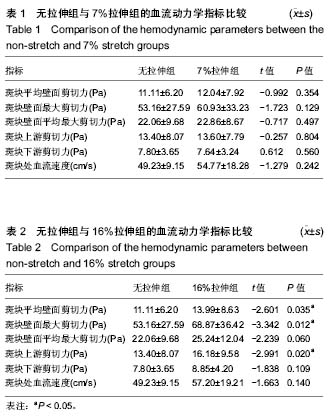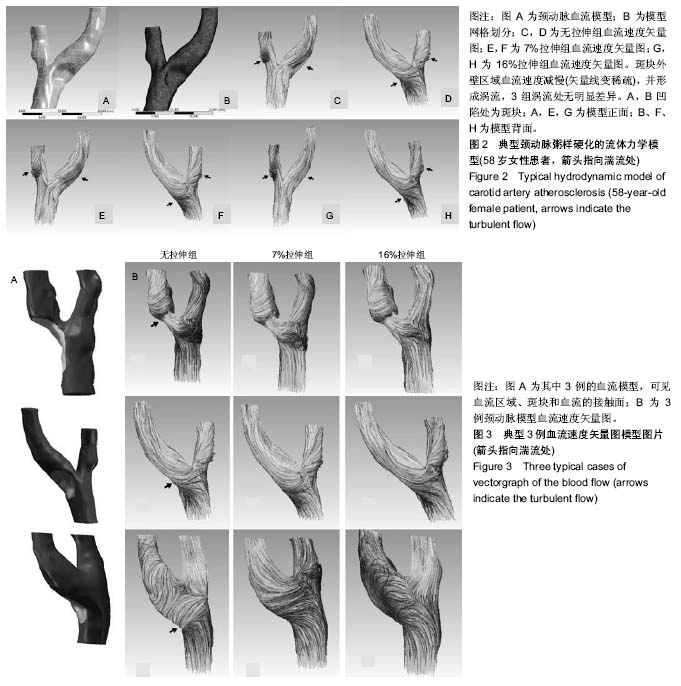中国组织工程研究 ›› 2019, Vol. 23 ›› Issue (15): 2403-2408.doi: 10.3969/j.issn.2095-4344.1174
• 组织构建实验造模 experimental modeling in tissue construction • 上一篇 下一篇
颈动脉粥样硬化的流体力学模型:旋转手法下颈动脉粥样硬化斑块的血流动力学变化
陈奕历1,劳永华2,张少群1,吴宝烽3,李义凯1
- (1南方医科大学,广东省广州市 510515; 2华南理工大学,广东省广州市 510006;3广州市惠爱医院,广东省广州市 510370)
Hydrodynamic model of carotid artery atherosclerosis: hemodynamic changes of carotid atherosclerotic plaques under cervical rotatory manipulation
Chen Yili1, Lao Yonghua2, Zhang Shaoqun1, Wu Baofeng3, Li Yikai1
- (1Southern Medical University, Guangzhou 510515, Guangdong Province, China; 2South China University of Technology, Guangzhou 510006, Guangdong Province, China; 3Guangzhou Huiai Hospital, Guangzhou 510370, Guangdong Province, China)
摘要:
文章快速阅读:
.jpg)
文题释义:
斑块壁面剪切力(average wall shear stress,AWSS):是时均和面均剪切力的综合,一个心动周期内斑块平均壁面剪切力的平均大小,即斑块长期受到的剪切力平均大小。
斑块最大壁面剪切力(maximum wall shear stress,Max_WSS):是一个心动周期内斑块处最大剪切力大小(某一时刻的一点),即斑块受到最大的剪切力。
斑块平均最大壁面剪切力(average maximum wall shear stress,Max_AWSS):是一个心动周期内,斑块受到最大剪切力时,斑块面所受到的平均壁面剪切力。
斑块上游剪切力、斑块下游剪切力:均和斑块壁面剪切力相同,也是时均和面均的综合,是斑块上下处长期受到的剪切力。
.jpg)
文题释义:
斑块壁面剪切力(average wall shear stress,AWSS):是时均和面均剪切力的综合,一个心动周期内斑块平均壁面剪切力的平均大小,即斑块长期受到的剪切力平均大小。
斑块最大壁面剪切力(maximum wall shear stress,Max_WSS):是一个心动周期内斑块处最大剪切力大小(某一时刻的一点),即斑块受到最大的剪切力。
斑块平均最大壁面剪切力(average maximum wall shear stress,Max_AWSS):是一个心动周期内,斑块受到最大剪切力时,斑块面所受到的平均壁面剪切力。
斑块上游剪切力、斑块下游剪切力:均和斑块壁面剪切力相同,也是时均和面均的综合,是斑块上下处长期受到的剪切力。
摘要
背景:颈椎旋转推拿手法是颈椎病的非手术治疗方法之一,其疗效显著,但对颈动脉粥样硬化患者的安全性仍待探讨。
目的:分析颈椎旋转手法下粥样硬化颈动脉的血流动力学改变,探讨颈椎旋转手法对斑块血流动力学影响。
方法:筛选颈动脉分叉处狭窄伴有斑块MRI影像资料8例。建立颈动脉粥样硬化的流体力学模型,赋予通用血流边界条件,模拟手法旋转颈椎时颈动脉拉伸情况,将模型拉伸为无拉伸的对照组、7%拉伸组、16%拉伸组,模拟斑块的血流动力学参数变化。血流动力学指标分别为斑块壁面剪切力、斑块最大壁面剪切力、斑块平均最大壁面剪切力、斑块上游剪切力、斑块下游剪切力、斑块处血流速度和血流矢量图,对拉伸组与无拉伸对照组进行对照分析。
结果与结论:①7%拉伸组的血流动力学指标与对照组比较均无显著性差异(P > 0.05);16%拉伸组的血流动力学指标与对照组相比,斑块壁面剪切力、斑块最大壁面剪切力及斑块上游剪切力增大(P < 0.05),其余指标无显著差异;②结果提示,旋转手法对颈动脉的不同拉伸对斑块的影响不同,大幅度16%应变的拉伸可能会影响斑块的血流动力学情况。
中国组织工程研究杂志出版内容重点:组织构建;骨细胞;软骨细胞;细胞培养;成纤维细胞;血管内皮细胞;骨质疏松;组织工程
ORCID: 0000-0002-9460-1581(陈奕历)
背景:颈椎旋转推拿手法是颈椎病的非手术治疗方法之一,其疗效显著,但对颈动脉粥样硬化患者的安全性仍待探讨。
目的:分析颈椎旋转手法下粥样硬化颈动脉的血流动力学改变,探讨颈椎旋转手法对斑块血流动力学影响。
方法:筛选颈动脉分叉处狭窄伴有斑块MRI影像资料8例。建立颈动脉粥样硬化的流体力学模型,赋予通用血流边界条件,模拟手法旋转颈椎时颈动脉拉伸情况,将模型拉伸为无拉伸的对照组、7%拉伸组、16%拉伸组,模拟斑块的血流动力学参数变化。血流动力学指标分别为斑块壁面剪切力、斑块最大壁面剪切力、斑块平均最大壁面剪切力、斑块上游剪切力、斑块下游剪切力、斑块处血流速度和血流矢量图,对拉伸组与无拉伸对照组进行对照分析。
结果与结论:①7%拉伸组的血流动力学指标与对照组比较均无显著性差异(P > 0.05);16%拉伸组的血流动力学指标与对照组相比,斑块壁面剪切力、斑块最大壁面剪切力及斑块上游剪切力增大(P < 0.05),其余指标无显著差异;②结果提示,旋转手法对颈动脉的不同拉伸对斑块的影响不同,大幅度16%应变的拉伸可能会影响斑块的血流动力学情况。
中国组织工程研究杂志出版内容重点:组织构建;骨细胞;软骨细胞;细胞培养;成纤维细胞;血管内皮细胞;骨质疏松;组织工程
ORCID: 0000-0002-9460-1581(陈奕历)
中图分类号:


.jpg)
.jpg) #br#
文题释义:#br#
斑块壁面剪切力(average wall shear stress,AWSS):是时均和面均剪切力的综合,一个心动周期内斑块平均壁面剪切力的平均大小,即斑块长期受到的剪切力平均大小。#br#
斑块最大壁面剪切力(maximum wall shear stress,Max_WSS):是一个心动周期内斑块处最大剪切力大小(某一时刻的一点),即斑块受到最大的剪切力。#br#
斑块平均最大壁面剪切力(average maximum wall shear stress,Max_AWSS):是一个心动周期内,斑块受到最大剪切力时,斑块面所受到的平均壁面剪切力。#br#
斑块上游剪切力、斑块下游剪切力:均和斑块壁面剪切力相同,也是时均和面均的综合,是斑块上下处长期受到的剪切力。#br#
#br#
#br#
文题释义:#br#
斑块壁面剪切力(average wall shear stress,AWSS):是时均和面均剪切力的综合,一个心动周期内斑块平均壁面剪切力的平均大小,即斑块长期受到的剪切力平均大小。#br#
斑块最大壁面剪切力(maximum wall shear stress,Max_WSS):是一个心动周期内斑块处最大剪切力大小(某一时刻的一点),即斑块受到最大的剪切力。#br#
斑块平均最大壁面剪切力(average maximum wall shear stress,Max_AWSS):是一个心动周期内,斑块受到最大剪切力时,斑块面所受到的平均壁面剪切力。#br#
斑块上游剪切力、斑块下游剪切力:均和斑块壁面剪切力相同,也是时均和面均的综合,是斑块上下处长期受到的剪切力。#br#
#br#